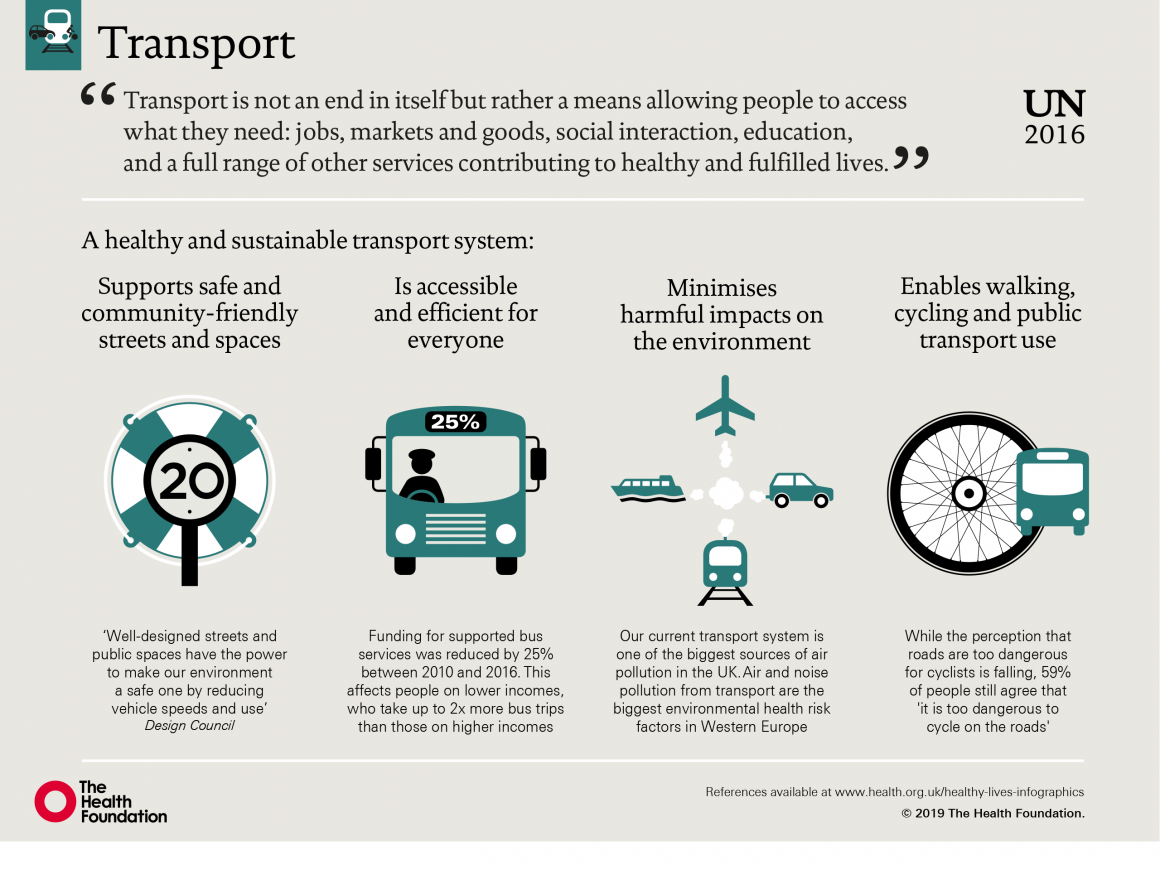Transport and health Why a transport system that better supports health and reduces inequalities is essential
28 March 2018

Transport is vital to us all as it allows us to see our family and friends, get to work, go on holiday, access education and health services, and do the activities that we enjoy.
More than half of the 24 million commuters in England and Wales say their commute increases their stress. Last year, I had to rely on a rural bus service to get to university and I know how stressful it can be when a commute is not efficient or affordable. The service was often delayed and unreliable, had a timetable that did not make rational sense and was also quite expensive. From this experience, it is quite easy for me to see how transport drives our health in multiple ways. In this infographic, the various links between transport and health are explored.
We want our series of infographics to be a useful resource to help change the conversation about what makes us healthy. You are welcome to download, save and share them for education and non-commercial use. Please make sure that no modifications are made and that the Health Foundation and the source is clearly acknowledged in full.
If you have any further questions about using our resources in your work please get in touch at website@health.org.uk
A healthy and sustainable transport system
Our transport system is made up of a diverse range of travel options and is much more than planes, trains and cars. It also includes buses, ferries and active forms of travel such as walking and cycling. But what does a healthy and sustainable transport system look like? Possible criteria include:
- Does it support safe and community-friendly spaces?
- Does it enable active travel and public transport use?
- Is it accessible and efficient for everyone?
- Does it minimise harmful impacts on the environment?
Supporting safe and community-friendly spaces
We explored in an earlier infographic how our surroundings have a major impact on our health. Transport infrastructure plays a significant role in shaping those surroundings. Having well-designed streets and public spaces can increase the attractiveness and safety of the environment. A transport system that makes it easier and safer for people to walk to the shops, schools and other amenities can help improve people’s health by reducing social isolation, which is harmful for physical and mental health especially among older people.
Enabling active travel
Active travel and public transport are a key part of any healthy transport system. More people walking and cycling for short journeys can help reduce road congestion and air pollution, save commuters money and improve people’s physical and mental health. With 20 million adults in the UK physically inactive, contributing to one in six deaths in the UK, active travel can help people incorporate physical activity into their daily routine. In London, investment in active transport infrastructure has seen the number of cycling trips rise to 670,000 per day in 2017, an increase of 130% since 2000. In Wales, the government has promoted active travel by passing the Active Travel (Wales) Act 2013 that requires all local authorities to support and enhance active travel planning and investment in Wales.
Ensuring accessibility
If a transport system is not accessible and efficient for everyone, it widens socio-economic inequalities by limiting some people’s ability to access good jobs and travel to health appointments, for example, as well as dictating how often they can see friends and family. Affordability is a huge driver of what type of transport a person uses. Those on the lowest incomes take two times as many bus trips as those in the highest income group and often face issues regarding frequency, reliability and convenience of bus services. While train fares are the subject of much attention in the national press, there is less attention on the cost of bus travel. Between 2005 and 2017, local bus fares in England rose by 66% on average.
Minimising harm
While transport will always produce some level of pollution (whether that is greenhouse gases or air, noise or light pollution), a healthy transport system seeks to minimise these emissions. Currently transport is the largest source of greenhouse gas emissions in the UK, producing more than a quarter of all greenhouse gases emitted in 2016. Air pollution has direct harmful effects on people’s cardiovascular and respiratory health, with outdoor air pollution estimated to contribute to 40,000 deaths a year in the UK.
The future of transport
Finally, we must think to the future of transport and we must start now. From 2040 there will be a ban on the sale of conventional petrol and diesel cars in an attempt to reduce air pollution. This is an opportunity to shape the future of transport and infrastructure so that it better supports health and reduces inequalities. The vision for the future is ambitious and ranges from the widespread adoption of electric and self-driving vehicles, all the way to Elon Musk’s futuristic Hyperloop systems that aim to blast people between cities through tunnels at speeds of up to 760 miles per hour.
However, we should not forget that we need to continue making less futuristic changes to our transport system too – such as making our streets better for pedestrians and cyclists. Whatever transport options do develop over the coming years, when making decisions about our future transport system we must ensure we do not miss this opportunity to reduce inequalities and improve health.
Robert Williams (@RobWillhealth) is a Healthy Lives Intern at the Health Foundation.
References
- United Nations quote
United Nation Secretary-General’s High-Level Advisory Group on Sustainable Transport. Mobilizing Sustainable Transport for Development. 2016.
Available from: https://sustainabledevelopment.un.org/content/documents/2375Mobilizing%20Sustainable%20Transport.pdf
- Funding for supported bus services was reduced by 25% between 2010 and 2016
- Campaign for Better Transport. Buses in Crisis: A report on bus funding across England and Wales 2010 – 2016. 2015
Available from: https://www.bettertransport.org.uk/sites/default/files/research-files/buses-in-crisis-2015.pdf
- People on low incomes take twice as many bus trips as those on high incomes
Department for Transport. Analyses from the National Travel Survey. 2018
Available from: https://www.gov.uk/government/uploads/system/uploads/attachment_data/file/674568/analysis-from-the-national-travel-survey.pdf
- Well-designed streets can reduce vehicle speeds and use
Design Council. The Value of Public Space. 2014
Available from: https://www.designcouncil.org.uk/resources/report/value-public-spaces
- Transport emissions are a major source of air pollution
Department for Environment Food & Rural Affairs. Emissions of Air Pollutants in the UK, 1970 to 2016. 2018
Available from: https://www.gov.uk/government/uploads/system/uploads/attachment_data/file/681445/Emissions_of_air_pollutants_statistical_release_FINALv4.pdf
- 59% of people think cycling is too dangerous
Department for Transport, British Social Attitudes Survey findings 2016.
Available from: assets.publishing.service.gov.uk/government/uploads/system/uploads/attachment_data/file/640297/british-social-attitudes-survey-2016.pdf
Related blogs
Work with us
We look for talented and passionate individuals as everyone at the Health Foundation has an important role to play.
View current vacanciesThe Q community
Q is an initiative connecting people with improvement expertise across the UK.
Find out more


